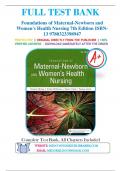FULL TEST BANK
Foundations of Maternal-Newborn and
Women's Health Nursing 7th Edition ISBN-
13 9780323398947
PRINTED PDF | ORIGINAL DIRECTLY FROM THE PUBLISHER | 100%
VERIFIED ANSWERS | DOWNLOAD IMMEDIATELY AFTER THE ORDER
Complete Test Bank, All Chapters Included
WEBSITE: MEDCONNOISSEURLIBRARIES.COM
EMAIL: MEDGEEK.DOCS@GMAIL.COM
,Med C File
, Foundations of Maternal-Newborn and Women's Health
Nursing 7th Edition Murray Test Bank
Chapter 01: Maternity and Women’s Health Care Today
Foundations of Maternal-Newborn & Women’s Health Nursing, 7th Edition
MULTIPLE CHOICE
1. A nurse educator is teaching a group of nursing students about the history of family-centered
maternity care. Which statement should the nurse include in the teaching session?
a. The Sheppard-Towner Act of 1921 promoted family-centered care.
b. Changes in pharmacologic management of labor prompted family-centered care.
c. Demands by physicians for family involvement in childbirth increased the practice
of family-centered care.
d. Parental requests that infants be allowed to remain with them rather than in a
nursery initiated the practice of family-centered care.
ANS: D
As research began to identify the benefits of early, extended parent–infant contact, parents
began to insist that the infant remain with them. This gradually developed into the practice of
rooming-in and finally to family-centered maternity care. The Sheppard-Towner Act provided
funds for state-managed programs for mothers and children but did not promote
family-centered care. The changes in pharmacologic management of labor were not a factor in
family-centered maternity care. Family-centered care was a request by parents, not physicians.
DIF: Cognitive Level: Application OBJ: Nursing Process Step: Planning
MSC: Patient Needs: Health Promotion and Maintenance
Expectant parents ask a prenatal nurse educator, “Which setting for childbirth limits the
amount of parent–infant interaction?” Which answer should the nurse provide for these
parents in order to assist them in choosing an appropriate birth setting?
e. Birth center
f. Home birth
g. Traditional hospital birth
h. Labor, birth, and recovery room
ANS: C
In the traditional hospital setting, the mother may see the infant for only short feeding periods,
and the infant is cared for in a separate nursery. Birth centers are set up to allow an increase in
parent–infant contact. Home births allow the greatest amount of parent–infant contact. The
labor, birth, recovery, and postpartum room setting allows for increased parent–infant contact.
DIF: Cognitive Level: Understanding OBJ: Nursing Process Step: Planning
MSC: Patient Needs: Health Promotion and Maintenance
2. Which statement best describes the advantage of a labor, birth, recovery, and postpartum
(LDRP) room?
a. The family is in a familiar environment.
b. They are less expensive than traditional hospital rooms.
c. The infant is removed to the nursery to allow the mother to rest.
d. The woman’s support system is encouraged to stay until discharge.
ANS: D
Med C File
, Sleeping equipment is provided in a private room. A hospital setting is never a familiar
environment to new parents. An LDRP room is not less expensive than a traditional hospital
room. The baby remains with the mother at all times and is not removed to the nursery for
routine care or testing. The father or other designated members of the mother’s support system
are encouraged to stay at all times.
DIF: Cognitive Level: Understanding OBJ: Nursing Process Step: Assessment
MSC: Patient Needs: Health Promotion and Maintenance
3. Which nursing intervention is an independent function of the professional nurse?
a. Administering oral analgesics
b. Requesting diagnostic studies
c. Teaching the patient perineal care
d. Providing wound care to a surgical incision
ANS: C
Nurses are now responsible for various independent functions, including teaching, counseling,
and intervening in nonmedical problems. Interventions initiated by the physician and carried
out by the nurse are called dependent functions. Administrating oral analgesics is a dependent
function; it is initiated by a physician and carried out by a nurse. Requesting diagnostic
studies is a dependent function. Providing wound care is a dependent function; however, the
physician prescribes the type of wound care through direct orders or protocol.
DIF: Cognitive Level: Understanding OBJ: Nursing Process Step: Assessment
MSC: Patient Needs: Safe and Effective Care Environment
4. Which response by the nurse is the most therapeutic when the patient states, “I’m so afraid to
have a cesarean birth”?
a. “Everything will be OK.”
b. “Don’t worry about it. It will be over soon.”
c. “What concerns you most about a cesarean birth?”
d. “The physician will be in later and you can talk to him.”
ANS: C
The response, “What concerns you most about a cesarean birth” focuses on what the patient is
saying and asks for clarification, which is the most therapeutic response. The response,
“Everything will be ok” is belittling the patient’s feelings. The response, “Don’t worry about
it. It will be over soon” will indicate that the patient’s feelings are not important. The
response, “The physician will be in later and you can talk to him” does not allow the patient to
verbalize her feelings when she wishes to do that.
DIF: Cognitive Level: Application OBJ: Nursing Process Step: Implementation
MSC: Patient Needs: Psychosocial Integrity
5. In which step of the nursing process does the nurse determine the appropriate interventions for
the identified nursing diagnosis?
a. Planning
b. Evaluation
c. Assessment
d. Intervention
ANS: A
Med C File




